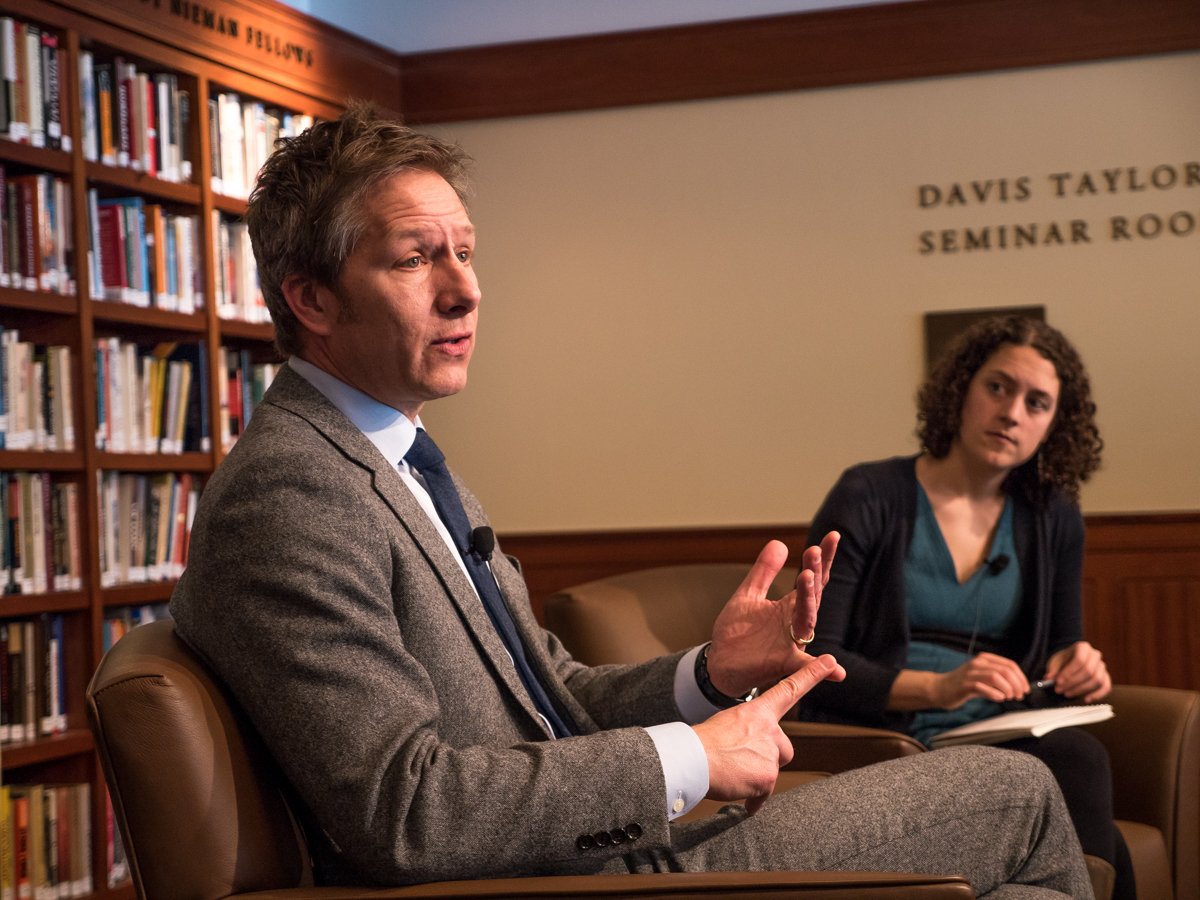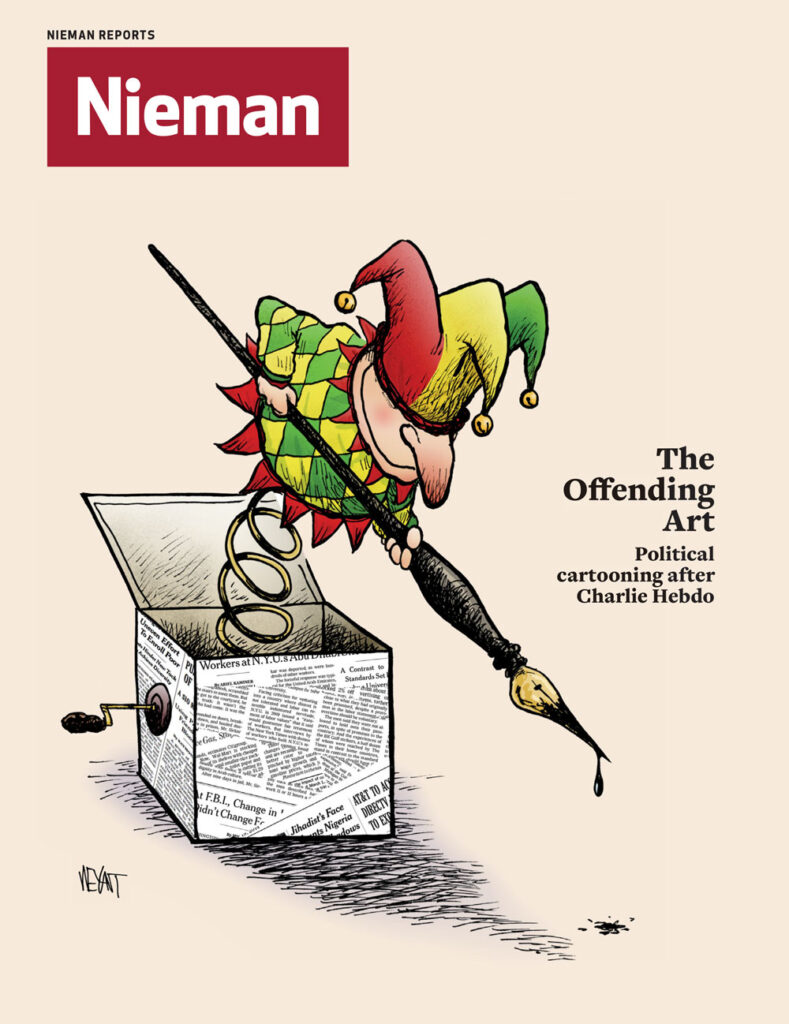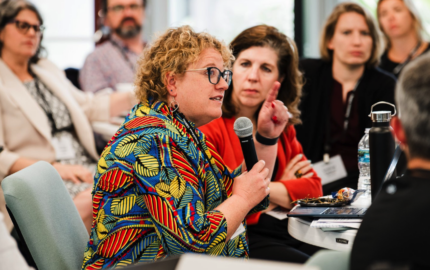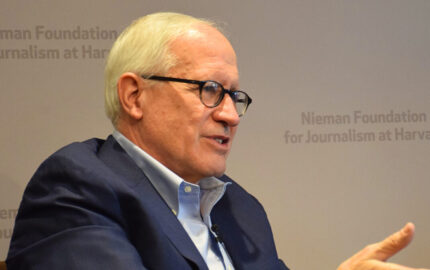Jay Lauf found a way around trouble early in his career. He wanted to be a journalist but when he couldn’t find a job he took a position selling ads for a trade magazine publisher. In 2001, as the dot-com bubble burst, he was hired as advertising director for Wired magazine, improved its finances, and was named publisher in 2006. Two years later he moved to The Atlantic as vice president and publisher. He helped usher the magazine into the digital age and was instrumental in the company’s launch of the online business publication Quartz three years ago. As publisher of Quartz, he is overseeing a global expansion. Lauf spoke at the Nieman Foundation in February. Edited excerpts:
On going short or long
We tend to focus on stories that are either short, meaning under 500 words, or longer, deeply investigated pieces. We use analytics as guideposts. Everything from the original interface of the site to the way we do our journalism is informed by data, but I think there’s as much art to it as there is science.
If you take a look at your top 100 stories in a given year, you can start to glean what works and what doesn’t. There are always exceptions to this rule. But what tends to work in the social ecosystem in terms of gaining traffic and gaining eyeballs is one of those two things, rather short or rather long stories. Either be succinct—usually that involves some infographics—or say the most definitive thing on a subject, make a must-read. Those are the things that people tend to share most or come back and read most.
What I see is if you submit a 600-word piece, not every time but a good chunk of the time, the editor’s going to say, “Does this really need to be that long?” If there’s a “there” there, it might be “Why don’t you take five more days or two more weeks and do more reporting and actually say something bigger? I think there’s a bigger point to be made here.”
We try to entertain and inform at the same time with charts. A chart can stand on its own on Quartz just like a cute picture of a cat might. In the same way that a cute cat video may be the hottest thing on BuzzFeed, Quartz content that has charts tends to be some of the highest-ranking articles in terms of traffic.
On hosting events
Events are a huge piece of The Atlantic, both in terms of revenue and brand stature. I love the fact that they give you a textural three-dimensional way to connect with the audience that I think ties them more closely to the brand. It’s an integral part of the business strategy for us. It’s always a slower go to build those than advertising, which is just transacted at a much more rapid pace.
On the Daily Brief e-mail newsletter
It comes out first thing in the morning in three broad time zones: Asia, Europe, and in the U.S. It’s one of our stellar products in terms of building a brand affinity. It has always had a better than 43 percent open rate, which is unheard of for e-mail newsletters. It’s grown organically so I think that helps with the open rate.
We do sell it out almost every day to a sponsor of one kind or another. In and of itself, it’s a very worthwhile venture, both commercially but also to proactively give readers a regular touch point with our brand.
On the importance of voice
How do we produce content that’s different from other websites? I think it’s voice-fulness. I think it’s not trying to cover everything, but we’re saying let’s cover the stuff that our readers are obsessed about. I think we’ve done a good job of establishing a voice and intelligence and keeping a focus on things that are important.
There are strategies that we’re tinkering with. One is the idea of Quartz being a global brand from the get-go and to speak in a post-national voice. I think we still speak with a pretty heavy American accent and I think we want to shed that over time. We do that by getting journalists who either have experience in, or are on the ground in, these different locales.
India is this first regional bet to try to customize a little bit. I don’t think our objective is to have a bunch of Balkanized international editions of Quartz. But India was big enough, complex enough, and distinct enough that we felt like here’s a place where we should try to cover it a little bit from the inside out. What we’ve done there is put Indian journalists on the ground in India so that our coverage does get into the subtleties. If you are either a British-based or anywhere but India-based journalist and you’re covering [Prime Minister Narendra] Modi in the election, you might over-explain, in some ways, elements of who he is or the dynamics. Whereas if you’re the Indian journalist, you might skip two paragraphs of set-up. I think it’s helped us to be more knowing in that sense. It’s an experiment. In January we eclipsed the million reader mark in India, so something’s going right there.
On advertising
All these advertisers are shifting their dollars increasingly to the Internet. Where’s that money coming from? It’s coming out of print in a big way. It’s coming out of TV a little bit, although TV seems to always have some stability.
I think a lot of companies want to do branding on the Internet. The advantage for Quartz is we’re giving them a place where they feel comfortable doing it. In order to do branding well, I think they need a couple of things. They need a clean canvas to paint on. That has not existed on the Web for a long time. It’s an ugly cacophony.
What we try to steer every advertiser toward is, don’t just do a flat billboard that doesn’t ask you to do anything. Create interactions. Use the interactive infographics that are catnip on our website in your advertising. Create sharing mechanisms. Then what we’ll do is, if you had a video embedded in your ad, we’ll tell you how many people watched the video and what the video completion rates were. Did they watch three seconds and punt or did they watch this whole three-minute video? Did they share it? If it’s an interactive infographic, how many people clicked on it how many times? Those are all proxies for how engaged people are.
On obsessions vs. beats
Some obsessions are not necessarily intuitive, like The Next Billion [Internet users] or the Internet of Everything.
I think where obsessions get very distinct and very powerful and differentiate us are in those more micro-obsessions. Alchemy is the word I use in that instance, because it is actually a little bit of data and a lot of editorial intuition. Our own editors are an obsessive bunch themselves. They tend to have generalist abilities but a handful of things that they themselves obsess about. It’s why you come up with a product like ChartBuilder. That was the product of one journalist who was obsessed with the fact that he couldn’t get charts built quickly and he just went deep on that and he coded it.
But then there is also looking at, “OK, what is our target audience obsessed with right now or going to be obsessed with?” Bitcoin was probably a combination of those two things when we obsessed about that. Abenomics was nobody’s obsession, probably, on our staff, but we felt like a slice of our audience is going to be really, really obsessed with that, and that’s something that’s important to cover.
Our own editors are an obsessive bunch. They tend to have generalist abilities but a handful of things that they obsess about
On hiring
What we hire for—and this seems obvious—is a natural curiosity. You don’t want somebody who just has experience and is only relying on that. You want somebody who’s constantly curious about the way the world is changing. Even the journalists who joined us in 2012, the world has shifted drastically on them, so that you better be curious, number one.
Number two, we do put a premium on quality. That can take a variety of forms. What their resume looks like and where they work, the work that they’re putting out. But quality is really important, particularly, again, on the social Web where quality comes in a lot of different shapes and sizes.
I don’t know that we overtly look for this, but we tend to attract—and actually this will make somebody jump up the list of priority—journalists who have some coding experience or are actually tech savvy in an engineering sense. That ChartBuilder product was built out of that.
On messaging apps
I think people think WhatsApp is often just for kids or the general public, but it’s not. In the same way, Twitter or Facebook was this funny little thing and then it was not. Messaging apps are becoming ubiquitous. There are big, big audiences to tap into.
We are tinkerers and experimenters so when you see something capturing that much of an audience, you’re going to want to experiment and tinker with it. Notifications and messaging seem to be a way that more and more people are getting information. That might be an area that you could see something from us.
I think a lot of publishers are making the mistake of trying to put all their eggs into the Facebook basket, and that feels a little dangerous to me.
On the homepage
Our homepage traffic has grown since we’ve launched, both in terms of percentage and overall traffic. “The homepage is dead,” we have said, but the truth is, even if 11 percent of our audience, up from 8 percent of our audience, is on the homepage, that’s something like one million or so people who are going to the homepage on a regular basis.
How do you treat them? Give them a reason and a reward for coming back. Maybe the Daily Brief e-mail newsletter is a way to create a homepage for Quartz that’s rewarding as a homepage. It will be interesting to see how this maps over time. We might be wrong on this, but the conventional wisdom would be that we want visitors to the homepage to quickly get deeper into Quartz, right? Our supposition right now is that our visitors want to be informed, and if we’re a news source, and if the homepage is a place where—after you’re stuck in this meeting with me for an hour—you want to quickly see what’s going on with the global economy, we can reliably give it to you there. Maybe the preference actually is “no, take me deeper.” We’re in the middle of that experiment right now.




